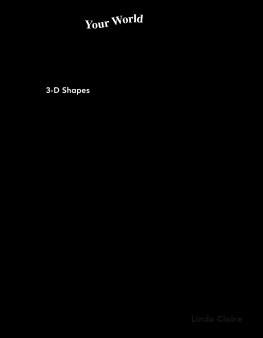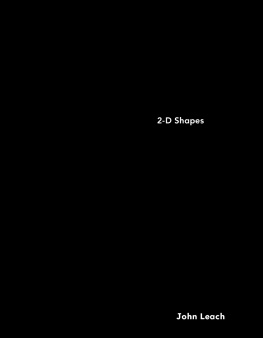
More titles in the Explore Your World! Series

Check out more titles at www.nomadpress.net
Nomad Press
A division of Nomad Communications
10 9 8 7 6 5 4 3 2 1
Copyright 2017 by Nomad Press. All rights reserved.
No part of this book may be reproduced in any form without permission in writing from
the publisher, except by a reviewer who may quote brief passages in a review or for limited educational use.
The trademark Nomad Press and the Nomad Press logo are trademarks of Nomad Communications, Inc.
ISBN Softcover: 978-1-61930-586-1
ISBN Hardcover: 978-1-61930-582-3
Educational Consultant, Marla Conn
Questions regarding the ordering of this book should be addressed to
Nomad Press
2456 Christian St.
White River Junction, VT 05001
www.nomadpress.net
3000500 BCE
Egyptians use geometry to measure amounts of crops. They also use math to build pyramids, tombs, and other structures.
16801620 BCE:
A scribe named Ahmes writes math documents about area and volume.
2000500 BCE:
Ancient Babylonians make a list, since called Plimpton 322, that has geometric ideas on it about cubic measurement.
1500200 BCE:
Indian mathematics is written in the ancient text of the Sulbasutras, including many measurement problems and methods for finding out the dimensions of circles.
1100-600 BCE:
Ancient Chinese mathematicians study right angles and triangles.
570560 BCE:
Pythagoras of Samos travels the world to discover information about math and science. He is noted to be the Father of the Right Triangle, though other people had discovered this before him.
400 BCE:
Euclid writes his famous book, The Elements , which is the foundation of the geometry we learn in school today.
350 BCE:
Hypatia is one of the first known female mathematicians. She studies geometry and translates classical mathematics books.
250 CE:
Liu Hui uses a polygon with 384 sides to figure out pi! He writes it in the book, Nine Chapters.
1637:
Rene Descartes writes Discourse on the Method and studies Euclidsdimensions.
1776-1831:
Sophie Germain studies geometry and is the first woman to win a prize from the French Academy of Sciences.
1815-1852:
Ada Lovelace works with Charles Babbage on patterns in math. She writes what is considered to be the worlds first computer program.
1800-1900:
Fractals are known as shapes found in clouds and fem plants. Once computers are invented, fractals are understood more.
1882-1935:
Emmy Noether is called a mathematical genius by Albert Einstein. She creates the general foundation for Einsteins theory of relativity. She earns a PhD in math, but cannot get a job because she is female and Jewish.
1905:
Albert Einstein creates the theory of relativity. There are many curves, spheres, and shapes in this theory.
1963:
Paul Cohen studies the continuum hypothesis, which states that numbers can go beyond infinity! This means they can go without limit.
2014:
Maryam Mirzakhani becomes the first woman to be awarded the prestigious fields Medal, awarded every four years to a young mathematition.


Did you know you have been doing math since you were born? Geometry can be found everywhere in our world and we begin noticing it even as babies! Geometry was there in the bars of your crib, the round bowl of mushed peas you threw on the kitchen floor, and even within the space taken up by the liquid in your cup.
WORDS TO KNOW
geometry: the math related to shapes, surfaces, points, lines , and solids.
point: a spot in space or on a line.
lines: many points in a row that make one length .
length: the measure of something from one end to the other, or how long something is.
mathematics: the study of ideas related to numbers. Mathematicians study mathematics.
Geometry is a type of mathematics that we find all around us. In fact, geometry shows us the size of the earth and the size or amount of everything thats on the earth. Wherever you are right now as you read this, you are surrounded by geometry!
GE-OM-ET-RY
The word geometry has four syllables. Try saying it: Ge-om-et-ry. Lets take a look at all the parts of this word. Ge is an ancient Greek word meaning Earth. The syllables -metry are an ending, or suffix. It shows that the word geometry has to do with a system. It comes from the ancient Greek word metria. That word is similar to the word measure, which is one of the definitions of metria. When you measure something, you are figuring out how big something is, how much space it takes up, or how much it weighs.
Look across the room at an object. What do you see? How far away do you think it could be? Think about that objects shape. What is the size? These questions and thoughts are about geometry. You seeyou are a mathematician, a person who studies math! Lets learn how geometry was part of our past.
GEOMETRY AND HISTORY

People started using geometry when our human ancestors went to work. They did not get in their cars and drive to the office or go to the store to take care of customers as your parents might do today.
Ancient humans had very different lives. They made tools for hunting. They made tools for cooking meals. Ancient humans built boats and homes.
WORDS TO KNOW
tally: to count the number of something.
scale: a tool used to weigh objects.
angle: the space between two lines that start from the same point, measured in degrees.
pattern: a series of repetitive connections and designs.
wavelength: the distance between two waves.
BCE: put after a date, BCE stands for Before Common Era and counts years down to zero. CE stands for Common Era and counts years up from zero. This book was published in 2017 CE.
solar calendar: a yearly calendar based on how long it takes the earth to move around the sun.
pyramid: a shape with a square base and triangles for sides that meet at a point.
square: a shape with four equal sides and four right angles.
triangle: a shape with three sides.
Measuring and building were happening thousands and thousands of years ago. Our ancient relatives counted and tallied . They made scales and used weights. All this work was related to geometry!
This was true about their art, too. Art is full of curves and lines. Ancient people carved shapes, curves, and angles in caves, in rock, and on trees. And what about music? There are patterns in sounds as well, and in the wavelengths that each sound makes invisibly in the air. All this geometry was happening around the world, in the Americas, Australia, Asia, the Middle East, and Africa.
In 4200 BCE , ancient Egyptians created a solar calendar . To do this, they looked at the stars and made measurements and found patterns.

Next page


















